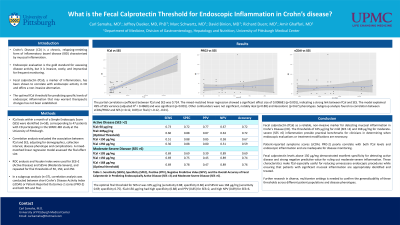Monday Poster Session
Category: IBD
P2649 - What is the Fecal Calprotectin Threshold for Endoscopic Inflammation in Crohn’s Disease?
Monday, October 28, 2024
10:30 AM - 4:00 PM ET
Location: Exhibit Hall E

Has Audio

Carl Samaha, MD
University of Pittsburgh Medical Center
Pittsburgh, PA
Presenting Author(s)
Carl Samaha, MD, David Binion, MD, Jeffrey Dueker, MD, MPH, Marc Schwartz, MD, Richard Duerr, MD, Amir Ghaffari, MD, PhD
University of Pittsburgh Medical Center, Pittsburgh, PA
Introduction: Fecal calprotectin (fCal) is an established biomarker of intestinal inflammation and screening test for IBD. It can be useful in monitoring mucosal inflammation in Crohn’s Disease (CD) since it correlates strongly with endoscopic scores. However, optimal thresholds of fCal, particularly in CD, are not established.
Methods: Data was retrospectively collected from University of Pittsburgh SPARC-IBD study participants. fCal tests within a month of a Simple Endoscopic Score (SES) were identified (n=58), corresponding to 47 patients. Correlation analysis evaluated the association between fCal and SES, adjusting for demographics, collection interval, disease phenotype and complications. A mixed-matched linear regression model assessed the fCal effect size. ROC analysis and Youden Index were used for SES >2 (Active Disease) and SES >6 (Moderate-Severe), and repeated for fCal thresholds of 50, 150, and 250. In a subgroup analysis (n=37), correlation analysis was conducted between short Crohn's Disease Activity Index (sCDAI) or Patient-Reported Outcomes-2 scores (PRO-2) and both SES and fCal.
Results: The partial correlation coefficient between fCal and SES was 0.724. The mixed-matched linear regression showed a significant effect size of 0.008681 (p< 0.001), indicating a strong link between FC and SES. The model explained 49% of SES variance (adjusted R² = 0.4868) and was significant (p< 0.001). Other confounders were not significant, notably ileal (p=0.88) and ileocolonic (p=0.67) phenotypes. The optimal fCal threshold for SES >2 was 105 µg/mg (sensitivity 0.88; specificity 0.60) and SES >6 was 168 µg/mg (sensitivity 0.69; specificity 0.75). fCal >150 µg/mg had high specificity (0.88) and PPV (0.85) for SES >2, and high NPV (0.89) for SES >6. Subgroup analysis found no correlation between sCDAI/PRO2 and SES (r=0.12, 0.09) or FC (r=-0.12, -0.01).
Discussion: Fecal calprotectin is a reliable non-invasive predictor of mucosal inflammation in CD, given the poor correlation with symptoms; neither PRO-2 or sCDAI were useful in predicting fCal or SES. A range of 105-168 µg/mg most accurately predicts mild disease and might rule out moderate-severe inflammation. Routine evaluation of fCal can guide need for endoscopic evaluation, symptomatic management, or treatment escalation. Further studies validating the performance characteristics of a minimum fCal to detect active mucosal inflammation in CD across multiple centers are needed.
Note: The table for this abstract can be viewed in the ePoster Gallery section of the ACG 2024 ePoster Site or in The American Journal of Gastroenterology's abstract supplement issue, both of which will be available starting October 27, 2024.
Disclosures:
Carl Samaha, MD, David Binion, MD, Jeffrey Dueker, MD, MPH, Marc Schwartz, MD, Richard Duerr, MD, Amir Ghaffari, MD, PhD. P2649 - What is the Fecal Calprotectin Threshold for Endoscopic Inflammation in Crohn’s Disease?, ACG 2024 Annual Scientific Meeting Abstracts. Philadelphia, PA: American College of Gastroenterology.
University of Pittsburgh Medical Center, Pittsburgh, PA
Introduction: Fecal calprotectin (fCal) is an established biomarker of intestinal inflammation and screening test for IBD. It can be useful in monitoring mucosal inflammation in Crohn’s Disease (CD) since it correlates strongly with endoscopic scores. However, optimal thresholds of fCal, particularly in CD, are not established.
Methods: Data was retrospectively collected from University of Pittsburgh SPARC-IBD study participants. fCal tests within a month of a Simple Endoscopic Score (SES) were identified (n=58), corresponding to 47 patients. Correlation analysis evaluated the association between fCal and SES, adjusting for demographics, collection interval, disease phenotype and complications. A mixed-matched linear regression model assessed the fCal effect size. ROC analysis and Youden Index were used for SES >2 (Active Disease) and SES >6 (Moderate-Severe), and repeated for fCal thresholds of 50, 150, and 250. In a subgroup analysis (n=37), correlation analysis was conducted between short Crohn's Disease Activity Index (sCDAI) or Patient-Reported Outcomes-2 scores (PRO-2) and both SES and fCal.
Results: The partial correlation coefficient between fCal and SES was 0.724. The mixed-matched linear regression showed a significant effect size of 0.008681 (p< 0.001), indicating a strong link between FC and SES. The model explained 49% of SES variance (adjusted R² = 0.4868) and was significant (p< 0.001). Other confounders were not significant, notably ileal (p=0.88) and ileocolonic (p=0.67) phenotypes. The optimal fCal threshold for SES >2 was 105 µg/mg (sensitivity 0.88; specificity 0.60) and SES >6 was 168 µg/mg (sensitivity 0.69; specificity 0.75). fCal >150 µg/mg had high specificity (0.88) and PPV (0.85) for SES >2, and high NPV (0.89) for SES >6. Subgroup analysis found no correlation between sCDAI/PRO2 and SES (r=0.12, 0.09) or FC (r=-0.12, -0.01).
Discussion: Fecal calprotectin is a reliable non-invasive predictor of mucosal inflammation in CD, given the poor correlation with symptoms; neither PRO-2 or sCDAI were useful in predicting fCal or SES. A range of 105-168 µg/mg most accurately predicts mild disease and might rule out moderate-severe inflammation. Routine evaluation of fCal can guide need for endoscopic evaluation, symptomatic management, or treatment escalation. Further studies validating the performance characteristics of a minimum fCal to detect active mucosal inflammation in CD across multiple centers are needed.
Note: The table for this abstract can be viewed in the ePoster Gallery section of the ACG 2024 ePoster Site or in The American Journal of Gastroenterology's abstract supplement issue, both of which will be available starting October 27, 2024.
Disclosures:
Carl Samaha indicated no relevant financial relationships.
David Binion: Abbvie – Grant/Research Support. Merck – Grant/Research Support. Takeda – Grant/Research Support.
Jeffrey Dueker indicated no relevant financial relationships.
Marc Schwartz indicated no relevant financial relationships.
Richard Duerr indicated no relevant financial relationships.
Amir Ghaffari indicated no relevant financial relationships.
Carl Samaha, MD, David Binion, MD, Jeffrey Dueker, MD, MPH, Marc Schwartz, MD, Richard Duerr, MD, Amir Ghaffari, MD, PhD. P2649 - What is the Fecal Calprotectin Threshold for Endoscopic Inflammation in Crohn’s Disease?, ACG 2024 Annual Scientific Meeting Abstracts. Philadelphia, PA: American College of Gastroenterology.
